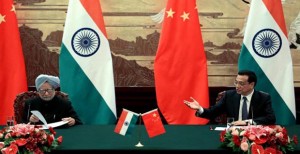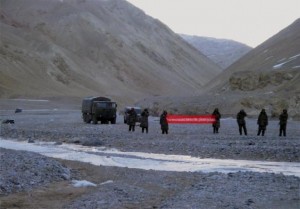
Chinese Premier Li Keqiang (right) and visiting Indian Prime Minister Manmohan Singh attend a media session at the Great Hall of the People in Beijing on October 23 2013.
Photo: China Daily/Wu Zhiyi
The 32-year dispute over the India-China border continues, even after the two countries signed an agreement only last month in the hope of ensuring that these contentions do not result in conflict.
The main area of continued disagreement is the furthest east Indian state of Arunachal Pradesh which China has renamed “South Tibet”, and has claimed historical ownership to many parts of the state. The term “South Tibet” did not exist before 2006. The issue of whether Tibet belongs to China at all has not been raised. Indian President Mukerjee aggravated China by visiting the state in November and commenting that the area is an important part of North East India, and a core aspect of future relations between India and South East Asia.
The Chinese have said that they would like to maintain peaceful relations with India despite these boundary issues. In reality, China has been strengthening its forces at the borders and is gradually taking pockets of land from India. It has now laid claim to approximately 640 sq km of land in the North West Indian state of Ladakh and has annexed 38,000 square km of the Aksai Chin plateau which neighbours Arunachal Pradesh. New Delhi continues to surrender to Beijing’s demands, with the recently signed Border Defence Cooperation Agreement (BDCA) containing nothing to stop China’s consistent border incursions. A K Antony, India’s Defence Minister, has admitted that the BDCA does not does not rule out actions on the frontier and that the primary purpose of the agreement is to give Beijing a clean slate over its breaches of the border-peace agreements of 1993, 1996, and 2005.

An undated photo shows Chinese troops with a banner asking Indian soldiers to go back in Daulat Beg Oldi sector of Ladakh.
Photo: PTI/ TheHindu
China’s refusal to clarify the Line of Actual Control (LAC), and the wording of the agreement, which is open to interpretation, means there is an apparent surrendering by India in these agreements. Despite this, Indian President Pranab Mukerjee has expressed his willingness to turn to military action if necessary, commenting “We do not have any tall ambition in increasing our borders, but at the same time we zealously need to protect our territorial integrity. Our armed forces give us the confidence in the nation’s ability to face any aggression and safeguard its interests”.
Alongside increasing tensions regarding Arunachal Pradesh, the two developing powers have also been pursuing an on-going water dispute as China plans to build four dams on the Brahmaputra river, or Yarlung Zangbo as it is known in Tibet, which supplies water to India and neighbouring Bangladesh. The agreement signed on these issues shows very little clarity or agreement between the two nations and asserts no control over China for it’s management of the water. The agreement even expresses India’s “appreciation” to China for selling flooding data, despite the fact that India supplies the same data to downstream Bangladesh and Pakistan for free.
Li Zeifei, an influential Chinese scholar, has commented that it is hypocritical of India to attempt to stop the building of dams in Tibet, as India herself has built many dams in Arunachal Pradesh to supply surplus water to areas of need without regard for Bangladesh which lies further down the waterline. The building of dams in this region has also helped India put its territorial mark on the disputed state.




 Print
Print Email
Email